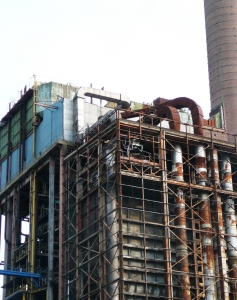Malignant mesothelioma is a rare form of cancer that is almost always associated with exposure to asbestos. When asbestos fibers are inhaled, they can become embedded in the lungs and other tissue known as the mesothelium. There is no way for doctors to see if the microscopic fibers are present without cutting a portion of the patient’s tissues and sending it to a pathology lab. There are also no symptoms for the first 20 to 50 years following exposure in most cases. While occasionally a tumor is found during an unrelated surgery, most patients do not find out until the disease is in a very advanced stage. Once an asbestos-related illness diagnosis is made, the patient is usually close to dying.
Continue reading
Appellate Court Reversed Ruling that Five Days of Asbestos Exposure was Insufficient to Cause Cancer
Proving when and where asbestos exposure occurred is often a critical element in mesothelioma injury lawsuits. According to a recent news article from the Louisiana Record, the state court of appeals has vacated a dismissal of an asbestosis lawsuit, holding that jury could find five days of asbestos exposure was sufficient to cause the deadly form of cancer.
 The court opinion filed on December 10, 2014 involved a plaintiff who alleged he contracted asbestosis while working at various jobs between 1953 and 2006. One of his jobs was working as a pipefitter at a factory for five days. While on that job, he installed and removed asbestos-laden gaskets. In this case, plaintiff and his wife alleged asbestos exposure during this five-day period was a substantial contributing factor to his developing asbestosis. His other responsibilities during that short timeframe involved cleaning up asbestos debris from other workers at the factory.
The court opinion filed on December 10, 2014 involved a plaintiff who alleged he contracted asbestosis while working at various jobs between 1953 and 2006. One of his jobs was working as a pipefitter at a factory for five days. While on that job, he installed and removed asbestos-laden gaskets. In this case, plaintiff and his wife alleged asbestos exposure during this five-day period was a substantial contributing factor to his developing asbestosis. His other responsibilities during that short timeframe involved cleaning up asbestos debris from other workers at the factory.
Plaintiff’s expert testified at trial this five-day exposure was likely above what we currently know to be safe occupational limits of asbestos exposure, and he opined this would have been a significant contributing factor in plaintiff’s illness.
Continue reading
Essex House Crumbles as Holyoke Deals with Asbestos Abatement
Throughout the Commonwealth of Massachusetts, cities and towns are faced with problems related to unsafe long-abandoned buildings than need to be demolished but can’t be, due to the presence of highly-toxic asbestos.
 According to a recent news article from WGCB, officials in Holyoke, Massachusetts are faced with this very problem with respect to the Essex House. The Essex house was built in 1880, and was among Paper City’s largest and most luxurious hotels. Now it is a crumbling, dangerous shell of its former glory, and the town wants it gone.
According to a recent news article from WGCB, officials in Holyoke, Massachusetts are faced with this very problem with respect to the Essex House. The Essex house was built in 1880, and was among Paper City’s largest and most luxurious hotels. Now it is a crumbling, dangerous shell of its former glory, and the town wants it gone.
Continue reading
Many Vintage Christmas Ornaments May Contain Asbestos Dust
Around this time of year, it is almost impossible to log onto Facebook without seeing pictures of your friend’s Christmas trees and other holiday decorations. While many have boxes full of treasured ornaments that have been in the family for decades, the Telegraph warns that many of these antique ornaments may contain asbestos and may pose a serious health risk.
 According to the news article, many vintage ornaments could be laced with toxic material. In fact, in the 1940s, the fake snow dusted on many of these ornaments was commonly made from pure asbestos.
According to the news article, many vintage ornaments could be laced with toxic material. In fact, in the 1940s, the fake snow dusted on many of these ornaments was commonly made from pure asbestos.
Unfortunately, there is no way to tell if the material contains asbestos without expensive materials testing at a laboratory. Since most people are not willing to send their ornaments to a laboratory for asbestos testing, in England authorities are recommending any vintage ornaments containing fake snow should be thrown away. This, of course, raises the issue of safe asbestos disposal, but given it the alternative, it seems better than having asbestos on your family Christmas tree.
Continue reading
Massachusetts Asbestos Superfund Finds New Use
The town of Billerica, located just north of Boston, is home to one of two Environmental Protection Agency (EPA) Superfund sites located in the Commonwealth of Massachusetts. This site, now known as Iron Horse Park and once known as the Billerica Repair Shops, was once a major repair facility for the Boston and Maine Railroad. The Billerica Repair Shops were built in 1913. Employees of the repair facility built a small neighborhood along the railroad line that was known as Garden City.
 According to a recent news article in the Lowell Sun, this area also contained a landfill that was a frequent dumping site for asbestos material used in the repair facility and surrounding industrial park. The site became so contaminated it was believed it would not be usable for decades. In the 1980s, the EPA made Iron Horse Park a Superfund and set about removing the asbestos and capping the landfill. Capping a landfill involves adding layers of gravel, stone, and topsoil in an effort to prevent asbestos dust, which can lead to inhalation of the deadly fibers.
According to a recent news article in the Lowell Sun, this area also contained a landfill that was a frequent dumping site for asbestos material used in the repair facility and surrounding industrial park. The site became so contaminated it was believed it would not be usable for decades. In the 1980s, the EPA made Iron Horse Park a Superfund and set about removing the asbestos and capping the landfill. Capping a landfill involves adding layers of gravel, stone, and topsoil in an effort to prevent asbestos dust, which can lead to inhalation of the deadly fibers.
Continue reading
Izell v. Union Carbide Corp.: Apportionment of Damages in Mesothelioma Cases
According to a recent case before the California Court of Appeal, defendant purchased an asbestos mine in Coalinga, California in the early 1960s. From the time of purchase until 1985, defendant supplied asbestos to companies that used it for products to be sold to the construction industry.
 Plaintiff was the owner of a construction company that built over 200 homes between the early 1960s and the mid-1980s. Plaintiff never personally worked as a builder or foreman on any of the home construction projects. He did, however, walk through the various construction sites on a regular basis. Each home was constructed with drywall that workers finished with premixed joint compound. After applying joint compound and allowing it to dry, workers then sanded it several times. Plaintiff was often present during the sanding process.
Plaintiff was the owner of a construction company that built over 200 homes between the early 1960s and the mid-1980s. Plaintiff never personally worked as a builder or foreman on any of the home construction projects. He did, however, walk through the various construction sites on a regular basis. Each home was constructed with drywall that workers finished with premixed joint compound. After applying joint compound and allowing it to dry, workers then sanded it several times. Plaintiff was often present during the sanding process.
Continue reading
Genetic Research Looks at How Mesothelioma Differs from Other Cancers
Not only is mesothelioma deadly, there is also no effective means to control or cure the disease, as there are with some forms of cancer. If it were not for exposure to asbestos, malignant mesothelioma would rarely occur.
 A recent article from Fox News looks at efforts by scientists to learn how mesothelioma forms and what can be done to treat the disease more effectively. One major difference discovered between mesothelioma and other forms of cancer is mesothelioma is likely caused by mutations in more than one cell.
A recent article from Fox News looks at efforts by scientists to learn how mesothelioma forms and what can be done to treat the disease more effectively. One major difference discovered between mesothelioma and other forms of cancer is mesothelioma is likely caused by mutations in more than one cell.
Most forms of cancer are considered monoclonal, that is they are caused from mutations within a single cell. In making this finding, scientists used a method called HUMARA to trace cells from female embryos. The studied involved taking a serious of samples from 14 mesothelioma tumors removed from female mesothelioma patients. Through a change involving the deactivation of one x chromosome, researchers were able to make this link.
Continue reading
Massachusetts Town Spends Decades Looking for Buyer for Old Asbestos-Laden Building
In the town of Belchertown, Massachusetts, residents have been waiting many years for the demolition of the State School for the Mentally Retarded. According to a recent news feature from New England Public Radio, prior to its closing in 1992, the school was often referred to as a snake pit.
 This was 20 years after it was revealed as part of a federal lawsuit that there were numerous hazardous and inhumane conditions at the school, including raw sewage in the cafeteria, toilets and showers in public areas, nonworking fire alarms, and incidents of abuse and neglect.
This was 20 years after it was revealed as part of a federal lawsuit that there were numerous hazardous and inhumane conditions at the school, including raw sewage in the cafeteria, toilets and showers in public areas, nonworking fire alarms, and incidents of abuse and neglect.
Continue reading
How Mesothelioma Changed a Woman’s Life After Diagnosis at Age 22
It is well known that mesothelioma is caused by exposure to asbestos fibers. When the fibers are inhaled, they can become lodged in a layer of tissue known as the mesothelium. The fibers are undetectable and cannot be removed by doctors. In time, normally 20 to 50 years, the fibers can metastasize into the deadly form of cancer known as mesothelioma, lung cancer, or other respiratory illness.
 It is for this reason that we normally think of older people being diagnosed with mesothelioma. However, a recent news article from the San Antonio Express discusses a tragic case of a woman diagnosed with mesothelioma at age 22.
It is for this reason that we normally think of older people being diagnosed with mesothelioma. However, a recent news article from the San Antonio Express discusses a tragic case of a woman diagnosed with mesothelioma at age 22.
As a young girl, she would frequently hug her father, sit on his feet, and grab his legs while he was covered in asbestos fibers from work. After inhaling the fibers, they became embedded in the tissue that lined her chest and caused tumors to form. At age 22, after having a baby, she was having her tubes tied when doctors discovered the tumors and diagnosed her with mesothelioma.
Continue reading
Genetically-Modified Cells May Prove Effective in Fighting Mesothelioma
As it stands today, mesothelioma is an incurable cancer.
However, researchers are making strides in treatment options. One of the best new methods of cancer treatment is the use of genetically-modified cells. As the LA Times reports, training the human immune system to recognize and fight cancer is now being called the the “fifth pillar” of cancer treatment. 
Boston mesothelioma lawyers know many of the treatments effective with other type of cancer frequently do not work as well for mesothelioma patients. This is also true of genetically-engineered cells. However, researchers at Memorial Sloan Kettering Cancer Center are taking a new approach that may work better.
Continue reading
 Mesothelioma Lawyers Blog
Mesothelioma Lawyers Blog



